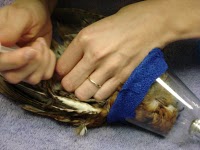 We are not really sure if this owl is a male or female, but we think it’s a female because of her size. She was known as “yellow-eyed screech” for several years because the other screech owl she lives with has gray eyes. However, we now call her “one-eyed screech” because she had one of her eyes removed last year. In 2005, she started showing signs of glaucoma in both of her eyes. Over time, the pressure in her right eye increased to a point we thought she might be in pain. Therefore, it was decided to have the right eye removed. The recovery from the surgery was better than any of us expected, and she is doing well with her remaining eye.
We are not really sure if this owl is a male or female, but we think it’s a female because of her size. She was known as “yellow-eyed screech” for several years because the other screech owl she lives with has gray eyes. However, we now call her “one-eyed screech” because she had one of her eyes removed last year. In 2005, she started showing signs of glaucoma in both of her eyes. Over time, the pressure in her right eye increased to a point we thought she might be in pain. Therefore, it was decided to have the right eye removed. The recovery from the surgery was better than any of us expected, and she is doing well with her remaining eye.
One-eyed screech was found injured in August of 1999 and taken to the Carolina Raptor Center to be rehabilitated. She had been hit by a car and received permanent wing damage that prevented her from being able to fly well. The Carolina Raptor Center gave her to us in November of 1999, and she now lives on exhibit in Carolina Wildlife. Currently, all of our raptors have wing or eye injuries that prevent them from being able to live in the wild, so they found a home with us instead.
Eastern screech owls are found in the eastern United States and southern Canada. Instead of building nests, they will use tree cavities. We turned an old exhibit tree cavity that was once used for flying squirrels into a nest place for our screech owls, but we never saw them use it. Their habitat varies in the wild, but they frequent woodland areas close to fields and meadows. They hunt many different things including small mammals, insects, birds, reptiles and fish. Our screech owls get a combination of dead mice and special “bird of prey” meat diet, along with added vitamins to ensure that they receive all their nutritional needs. In the wild, they typically will sit in a low branch and wait for their prey to come by, and then use the swoop-and-grab method. These raptors are pretty small in comparison to other owls, only averaging 8-9 inches in length and weighing 6-8 ounces.
Below are some pictures that were taken while preparing for one-eyed screech’s surgery. And if you are interested in learning about our red-tailed hawk Misha (with an eye injury from a bee bee pellet), you can click here to see his creature feature.
The information in this post can be found at http://www.carolinaraptorcenter.org/es_owl.php.

My favorite blog from the museum of life and science. Always informative and educational with a little back history and comedy as well. Marilyn you do an amazing job and I always feel so connected to the animals I read about that I want to rush out and see them the next day.